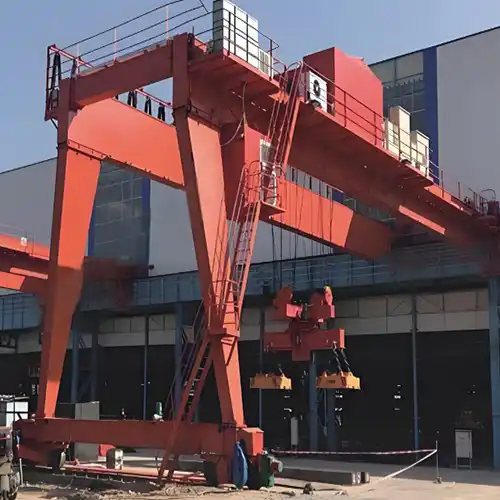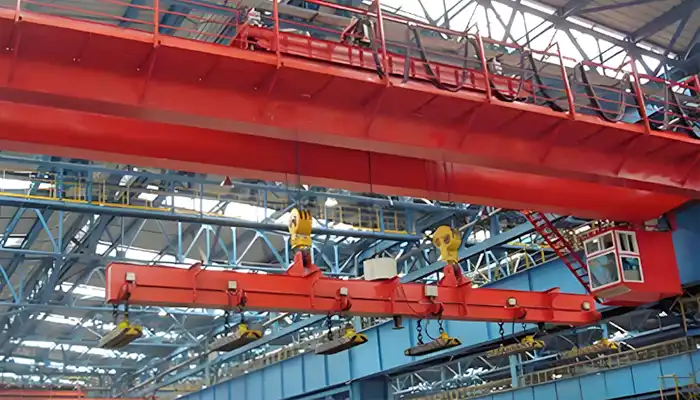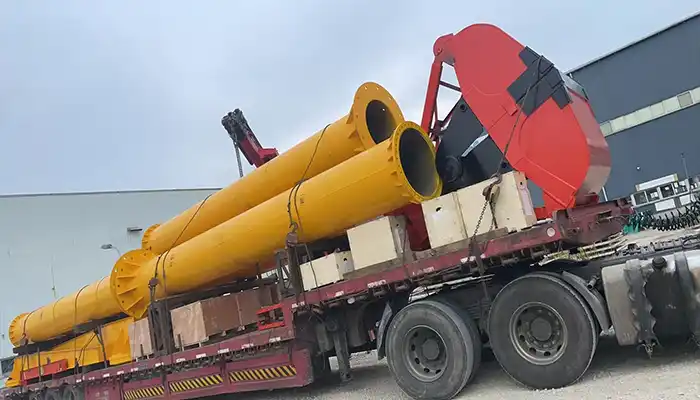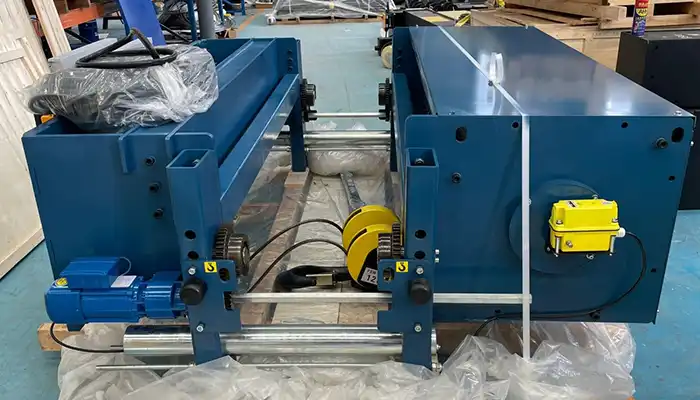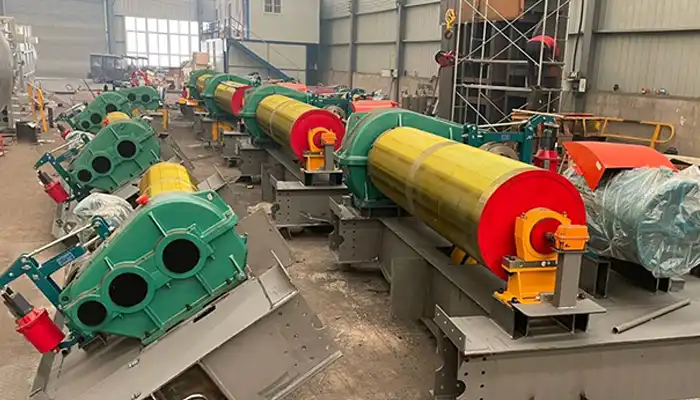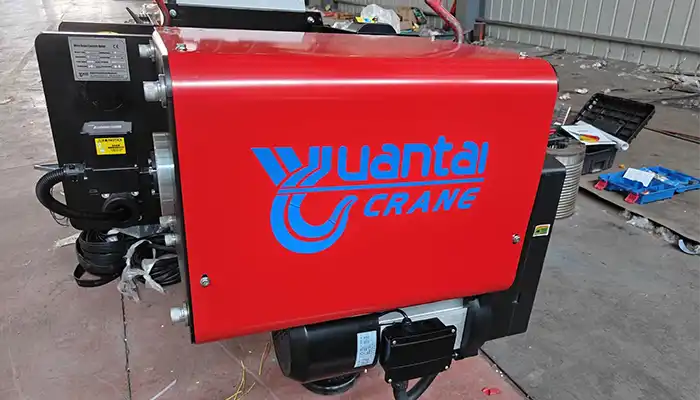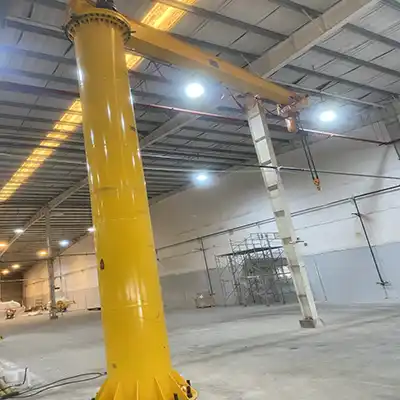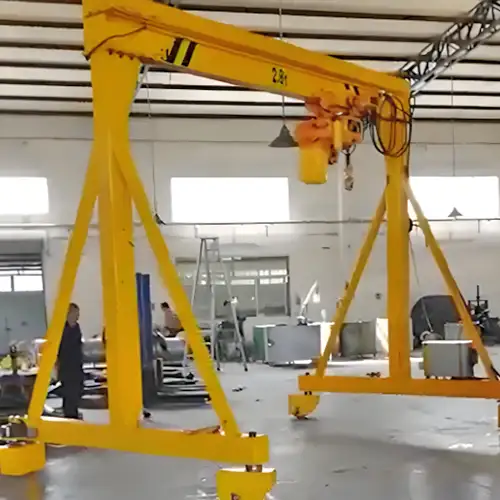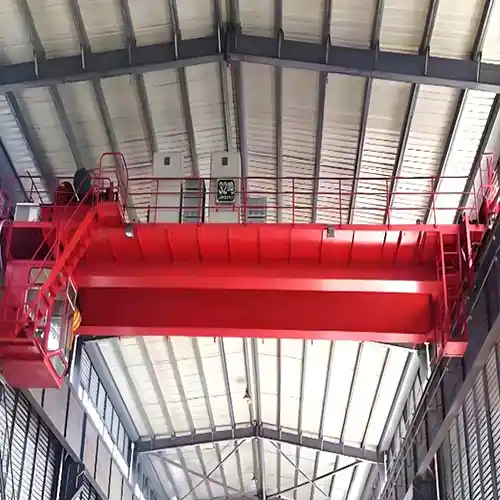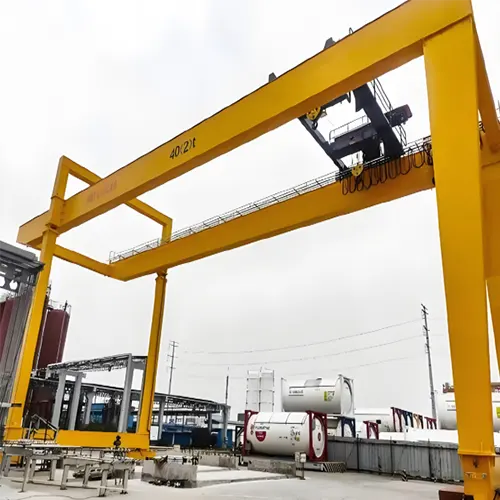Hot Billet Handling: Electromagnetic Crane vs. Clamp Cranes
Choosing the right crane for hot billet handling—electromagnetic cranes for quick lifts or clamp cranes for controlled, versatile handling.
Category: Featured
Your Trusted Steel Mill Crane Manufacturer & Supplier
Hot Billet Handling: Electromagnetic vs. Clamp Cranes
Choosing the right crane for hot billet handling—electromagnetic cranes for quick lifts or clamp cranes for controlled, versatile handling.
Comprehensive Guide to Hot Billet Handling and Selecting the Right Crane
Overview of Hot Billet Handling
Hot billet handling refers to the process of lifting, transporting, and storing steel billets that are at high temperatures. This is a critical operation in steel mills and foundries. The billets are often used as raw material for rolling into bars, rods, or other steel products.
Handling hot billets is challenging due to the extreme heat. The billets can reach temperatures as high as 1,200°C, making it difficult to handle them safely and efficiently. Improper handling can lead to accidents, material damage, and operational delays.
Challenges in Handling Hot Billets
- High Temperature: The heat can damage lifting equipment and pose safety risks to operators.
- Heavy Loads: Steel billets are heavy and require strong equipment capable of lifting large loads.
- Precision: Hot billets must be handled precisely to avoid accidents and ensure smooth operations.
- Speed: The need to move billets quickly to maintain production flow adds pressure to handling methods.
- Equipment Durability: Constant exposure to high temperatures can shorten the lifespan of cranes and other handling equipment.
Purpose of the Guide
- Insight into Hot Billet Handling: This guide offers practical insights on how to handle hot billets efficiently, ensuring both safety and productivity.
- Selecting the Right Crane: It helps you choose between electromagnetic billet cranes and clamp cranes, highlighting the pros and cons of each, based on your facility’s specific needs.
The goal is to ensure you choose the most effective billet crane for your operations. We have billet handling overhead crane, billet gantry crane, electromanetic billet crane, and clamp billet handling for your reference. If you have any need, please feel free to contact us.
Hot Billet Handling: Key Considerations
Temperature and Material Properties
- Effect on Materials: Hot billets are often at temperatures ranging from 900°C to 1,200°C. This extreme heat can alter the properties of materials, including steel, making them more susceptible to deformation.
- Effect on Equipment: Lifting equipment must withstand high temperatures to avoid damage. Over time, exposure to heat can weaken crane components and reduce their operational lifespan.
Risks Associated with Handling Hot Billets
- Burns and Injuries: Operators face significant risks of burns from accidental contact with hot billets or hot equipment. Even handling tools can become dangerously hot.
- Material Damage: If not handled correctly, the billets may become deformed or damaged, leading to production delays.
- Equipment Failure: Crane components like cables, motors, or hooks can degrade under high-temperature conditions, leading to costly breakdowns and downtime.
Safety Protocols
- Operator Safety: Ensuring the safety of operators is paramount. Training workers to handle hot billets with proper techniques is essential to prevent accidents.
- Protective Equipment:
- Gloves and Heat-Resistant Clothing: Protecting hands and arms with heat-resistant gloves and clothing helps reduce the risk of burns.
- Helmets and Face Shields: Helmets and face shields protect operators from flying debris and intense heat.
- Automatic Safety Features: Safety features such as automatic shutoffs, alarms, and safety brakes can prevent accidents and equipment damage.
Efficiency in Handling
- Optimized Systems: The key to smooth operations lies in optimizing the lifting and transportation systems. An efficient crane or handling system helps maintain a steady flow in the production process.
- Consequences of Inefficiency: Slow or inaccurate handling can cause delays, affecting the entire production line. Inefficiencies lead to increased downtime, higher costs, and even accidents.
Effective hot billet handling requires both safe procedures and optimized equipment to ensure smooth, uninterrupted operations.
Electromagnetic Billet Cranes
How They Work: Electromagnetic billet cranes use powerful magnets to lift billets. The magnets create a strong magnetic field, allowing them to pick up and transport billets without direct contact. This reduces the risk of damaging the billets and the equipment.
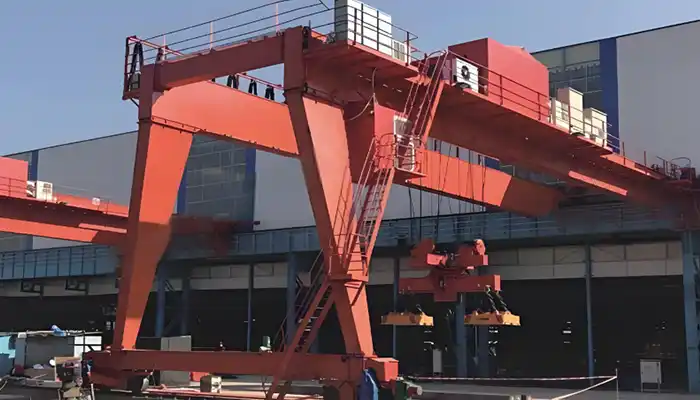
Electromagentic gantry crane for billet handling
Advantages:
- Speed and Efficiency: Quick lifting and release, leading to faster operations and reduced downtime.
- No Physical Contact: Eliminates the risk of surface damage or deformation to the billets.
- Less Labor-Intensive: Operators don't need to manually handle the billets, reducing physical effort and hazards.
- Space Efficiency: The crane lifts billets from above, freeing up valuable space in the workshop or mill.
Limitations:
- Material Limitations: Only suitable for ferrous materials like steel or iron billets. Non-ferrous billets cannot be handled.
- Temperature Sensitivity: Extremely high temperatures can weaken the magnetic field, reducing lifting efficiency.
- Maintenance Needs: Regular checks and maintenance of the magnets are essential, especially in high-temperature environments.
- Power Supply Dependency: Requires a stable electrical power source to function properly.
Clamp Cranes for Billets
Types of Clamp Cranes:
- Scissor-Type Clamps: Use a scissor mechanism to grip and lift billets, suitable for various billet sizes and shapes.
- Billet Lifting Tongs: Specifically designed for hot billets, these tongs securely grip and lift billets in steel mills or foundries.
When to Choose Clamp Cranes:
- Non-Ferrous Materials: Clamp cranes are ideal when handling non-ferrous billets, which electromagnetic cranes can't lift.
- Multiple Billets: These cranes can handle multiple billets at once, improving operational efficiency.
- Irregular Shapes or Sizes: Clamp cranes offer more precision for lifting billets with non-standard shapes or sizes.
- Versatility: Useful for a variety of lifting tasks, especially in areas where electromagnetic cranes aren’t feasible.
Handling Multiple Billets:
- Scissor-Type Clamps: Can open wide enough to handle several billets simultaneously, saving time and improving productivity.
- Billet Lifting Tongs: Customizable to lift and transport multiple billets stacked together, making them a great option for large-scale operations.
Electromagnetic cranes excel in fast, efficient lifting of ferrous billets in high-temperature environments. Clamp cranes, on the other hand, are better for handling non-ferrous materials, irregular billets, or multiple billets at once.
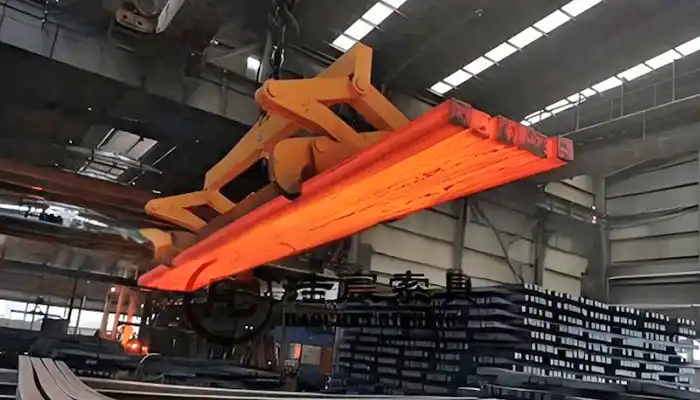
Hot billet handling clamp overhead crane

Billet clamp gantry crane
Factors to Consider When Selecting a Crane
Load Capacity
- Matching Crane Capacity to Billet Weight: Crane capacity should match the weight of the billets being handled. Billets typically range from 3 to 32 tons, so it’s crucial to select a crane with the appropriate load capacity to avoid overloading and ensure safe lifting.
- Single vs. Double Girder Design:
- Single Girder Cranes: Ideal for lighter loads, typically up to 10-15 tons. They are more cost-effective but less stable for heavy-duty operations.
- Double Girder Cranes: Suitable for heavier billets, offering better stability and lifting power for loads up to 32 tons. They are more robust but come at a higher price point.
Lifting Range
- Span Requirements and Reach: Consider how far the crane needs to reach across the workshop or mill. A wider span is required for maneuvering billets in larger spaces, while a more compact crane may be needed for smaller, confined areas.
- Crane Travel Distance and Lifting Height: Ensure the crane can travel the necessary distance to move billets throughout the facility. The lifting height should also be suitable for stacking billets or moving them to elevated positions. An adjustable lifting height could be a beneficial feature in some cases.
Temperature Tolerance
- Material Durability Under High Temperatures: Crane materials must withstand extreme heat without compromising structural integrity. Hot billets can reach temperatures over 1,200°C, which demands high-temperature-resistant materials.
- Special Coatings and Materials: Look for cranes made from heat-resistant materials, such as alloys that can handle high temperatures. Additionally, special coatings can protect critical crane components from heat damage, improving lifespan and reducing maintenance costs.
Control and Safety Features
- Automatic Opening and Closing for Clamp Cranes: For clamp cranes, automatic opening and closing mechanisms are essential. These systems ensure safe and efficient operation by reducing the risk of human error while speeding up the lifting process.
- Safety Features for Electromagnetic Cranes:
- Overload Protection: Prevents the crane from lifting loads that exceed its capacity, avoiding potential damage to both the crane and the billet.
- Safety Brakes: Essential for preventing accidents and ensuring the crane can safely stop in case of an emergency.
- Automatic Monitoring Systems: Modern cranes come equipped with sensors that monitor crane performance in real-time, alerting operators to issues like overloads or malfunctions.
Environmental Considerations
- Extreme Conditions: Cranes used in steel mills often operate in harsh conditions. Dust, humidity, and high temperatures can all impact crane performance. Ensure the crane is designed to handle these factors without suffering from wear and tear.
- Resistance to Corrosion or Wear: Exposure to heat, moisture, and harsh chemicals can cause corrosion or material degradation. Cranes designed for hot billet handling should feature corrosion-resistant materials or protective coatings to ensure long-term durability.
When selecting a crane, it's crucial to consider factors such as load capacity, lifting range, temperature tolerance, and safety features. The right crane will help maintain safe, efficient operations while handling hot billets in demanding environments.
How Electromagnetic Billet Cranes Work
Principles of Electromagnetic Lifting
Magnet System and Magnetic Fields: Electromagnetic billet cranes use a powerful magnet system to generate a strong magnetic field. This magnetic field is created when an electric current flows through the coils of the electromagnet. The magnetic force generated by the field is used to pick up and hold the billet securely. When the current is turned off, the magnetic field weakens, allowing the billet to be released.
Types of Electromagnetic Lifting Systems:
- Permanent Magnets: These magnets are always magnetized and are used in cranes where the lifting magnet does not need to be turned off frequently. They are often simpler, more durable, and require less maintenance.
- Electromagnets: These magnets are energized by an electric current and can be turned on and off. They offer greater control over the lifting process and are more commonly used in industrial applications where billets need to be lifted and released frequently.
Advantages of Electromagnetic Cranes
- Quick Attachment and Detachment: Electromagnetic cranes allow for rapid attachment and detachment of billets. This reduces the time needed to pick up and drop off materials, increasing the overall speed of operations.
- No Physical Contact with Billets: One of the key advantages of electromagnetic cranes is that they do not need to physically touch the billet. This minimizes the risk of damaging the billet’s surface, as no direct contact is made during lifting and transport.
- Increased Operational Speed: Since electromagnetic cranes operate quickly and efficiently, they contribute to faster turnaround times, helping improve overall productivity and throughput in steel mills and foundries.
- Reduced Labor Requirements: Electromagnetic cranes can be operated remotely, meaning fewer personnel are needed to assist with the lifting and moving of billets. This reduces the risk of accidents and helps improve workplace safety.
Limitations of Electromagnetic Cranes
- Limited to Ferrous Materials: Electromagnetic cranes are only effective for lifting ferrous materials, such as steel and iron billets. They cannot handle non-ferrous metals like aluminum or copper, which limits their versatility.
- Challenges in High-Temperature Handling: While electromagnetic cranes are efficient, their performance can be affected by extreme temperatures. High temperatures may weaken the magnetic field or damage the crane components over time, necessitating regular maintenance and temperature-resistant materials.
- Crane Maintenance: Electromagnetic cranes require regular maintenance to ensure the magnets continue functioning properly. The crane’s magnet system must be checked frequently to prevent malfunctions, particularly in high-temperature environments where wear and tear are common.
Electromagnetic billet cranes are highly efficient and useful for handling ferrous billets quickly and safely. However, they come with limitations, such as their reliance on ferrous materials and potential challenges in extreme heat conditions.
How Clamp Cranes Work for Billet Handling
Principles of Clamp Cranes
Hydraulic or Mechanical Systems: Clamp cranes use hydraulic or mechanical systems to grip and lift billets. These systems operate through powerful hydraulic cylinders or mechanical levers that open and close the clamps, securely holding the billets for transport. The gripping mechanism ensures a strong, stable hold, even for irregularly shaped billets.
Types of Clamp Attachments:
- Scissor Clamps: These clamps use a scissor-like mechanism to open and close, providing a strong, stable grip on billets. They are particularly effective for gripping billets of varying sizes and shapes.
- Billet Lifting Tongs: Specially designed for lifting steel billets, these tongs securely grab the billets with minimal surface damage. They offer a high level of precision and control.
Advantages of Clamp Cranes
- Versatility with Billet Shapes and Sizes: Clamp cranes are ideal for handling a wide range of billet shapes and sizes. Whether the billets are long, short, irregularly shaped, or have different cross-sections, the crane can adjust to grip them securely.
- Handling Multiple Billets Simultaneously: Clamp cranes are capable of lifting multiple billets at once, which improves operational efficiency, especially in large-scale operations where several billets need to be moved at the same time.
- Ideal for Controlled Lifting in Narrow Spaces: The design of clamp cranes makes them perfect for handling billets in narrow or confined spaces. Their precision and control allow for safe and efficient lifting in tight areas, such as in warehouses or compact workshops.
Limitations of Clamp Cranes
- Slower Than Electromagnetic Cranes: Clamp cranes are generally slower than electromagnetic cranes due to the physical engagement required to grab and lift the billets. This slower pace can affect operational efficiency when speed is a priority.
- Requires Additional Coordination for Safe Operation: Because clamp cranes rely on physical contact with the billets, they require more operator coordination. This includes ensuring the correct positioning of the crane, the safe engagement of the clamps, and careful handling to avoid damaging the billets.
Clamp cranes are versatile and precise, making them ideal for handling various billet shapes and sizes, as well as lifting multiple billets simultaneously. However, they are slower than electromagnetic cranes and require more operator involvement to ensure safety and efficiency.
How to Choose Between Electromagnetic and Clamp Cranes
Application Requirements
- When to Use Electromagnetic Cranes: Electromagnetic cranes are best for fast and efficient billet handling, especially when you need to move billets quickly and with minimal human intervention. They are ideal for lifting ferrous billets, such as steel or iron, in high-temperature environments where speed and precision are crucial. If you are handling billets that are uniform in shape and weight, electromagnetic cranes offer significant advantages in speed and automation.
- When to Use Clamp Cranes: Clamp cranes are more suitable for specific billet handling needs, such as when billets have irregular shapes, sizes, or require stacking. They are also better for lifting non-ferrous materials, which electromagnetic cranes cannot handle. If you are dealing with billets that need precise control in narrow spaces or when handling multiple billets simultaneously, clamp cranes are the better option.
Space and Layout Considerations
- Which Crane Type is Better for Your Workshop or Mill Layout?
Consider the available space and layout in your workshop or mill when choosing between electromagnetic and clamp cranes. Electromagnetic cranes require less physical space since they can be mounted overhead and don't require direct contact with the billets. They are ideal for larger, open spaces.
On the other hand, clamp cranes may be better suited for smaller workshops with confined spaces, as they allow for more control and precision in tight areas.
- Impact on Workshop Flow and Space Utilization: Electromagnetic cranes improve space efficiency by lifting billets from above, freeing up the floor for other tasks or machinery. However, clamp cranes require more space to operate, especially when handling multiple billets or larger loads. The choice of crane type will influence how smoothly materials can be moved throughout the workshop, and how effectively space is utilized.
Cost and Maintenance
- Upfront Costs: Electromagnetic cranes generally have higher upfront costs due to their advanced magnet systems and electrical requirements. However, their speed and automation can lead to improved productivity, which may justify the higher cost. Clamp cranes, particularly those using hydraulic or mechanical systems, tend to have a lower initial investment.
- Long-Term Maintenance Costs: Electromagnetic cranes require regular maintenance, especially for the magnets and electrical components, which can be costly over time. The maintenance of these cranes is crucial in high-temperature environments, where the magnets may weaken or get damaged. Clamp cranes, while having fewer electrical components, also require maintenance, especially for the hydraulic or mechanical systems. However, they are generally simpler and may be more cost-effective to maintain in the long run.
- Maximizing Cost-Effectiveness: To maximize cost-effectiveness, it’s essential to consider how often and how efficiently the crane will be used. If high-volume, fast lifting is required, the higher upfront cost of electromagnetic cranes may be worthwhile. However, if your needs are more diverse or specific, such as handling irregular billets or non-ferrous materials, clamp cranes may provide better value over time.
In conclusion, choosing between electromagnetic and clamp cranes depends on your specific needs, the layout of your facility, and the long-term investment in maintenance and efficiency. Consider the application, space requirements, and costs carefully to make the best decision for your operations.
Maintenance and Care for Hot Billet Handling Cranes
Routine Maintenance
Importance of Regular Inspections: Routine maintenance is crucial for both electromagnetic and clamp cranes to ensure they operate efficiently and safely. Regular inspections help identify potential issues before they become major problems, reducing downtime and extending the crane's lifespan.
Common Maintenance Tasks for Both Types of Cranes:
Electromagnetic Cranes:
- Inspect Magnets: Regularly check the magnets for wear, dirt, or cracks. Clean them to ensure they maintain their magnetic strength.
- Electrical System Checks: Inspect wiring and power systems for signs of wear or damage. Ensure connections are secure and free of corrosion.
- Lubrication: Ensure all moving parts are well-lubricated to minimize friction and wear, especially on the crane's hoisting mechanism.
Clamp Cranes:
- Hydraulic System Maintenance: Check the hydraulic fluid levels and inspect hoses for leaks or damage. Replace seals and gaskets as needed to prevent oil leaks.
- Mechanical Systems: Ensure that mechanical components such as the scissor clamps or lifting tongs operate smoothly. Lubricate joints and check for signs of wear or misalignment.
- Safety Mechanisms: Regularly check safety systems, such as overload protection and automatic locking mechanisms, to ensure they function properly.
Troubleshooting Common Issues
Electromagnetic Crane Issues:
- Electromagnetic Field Loss: If the crane is losing its magnetic grip, it may be due to a weak magnetic field. This could be caused by power supply issues or damaged coils. Troubleshoot by inspecting the electrical components and testing the magnets' performance under load.
- Overheating: Overheating can damage the magnet and electrical components. Ensure the crane operates within its temperature limits and consider installing cooling systems if needed. Regularly inspect and clean components to prevent heat buildup.
Clamp Crane Issues:
- Mechanical Failures: Issues such as bent or damaged lifting tongs or scissor clamps can occur due to wear or misuse. Check for cracks or excessive wear and replace components if needed.
- Hydraulic Failures: Hydraulic systems can develop leaks, or the fluid may become contaminated. Inspect hoses and seals regularly and replace them as needed. Ensure the hydraulic fluid is topped up and clean to maintain smooth operation.
Preventive Measures for Crane Lifespan:
- Regular Lubrication: Ensure all moving parts are well-lubricated to reduce friction and prevent premature wear.
- Component Replacement: Regularly replace worn components before they cause bigger problems. For example, replace the hydraulic seals and electrical parts as they show signs of aging.
- Cleaning: Keep all crane parts clean from debris, dust, or corrosion. This helps maintain performance and prevents unnecessary wear.
Safety and Maintenance Protocols
Maintaining Safety Features:
- Brakes and Overload Protection: Regularly inspect the crane's brakes and overload protection systems. Test brakes to ensure they can hold loads securely, and check that overload alarms are functioning properly.
- Automatic Opening Systems: If the crane has automatic opening or closing systems, check the sensors and ensure they are aligned correctly. Look for wear on the moving parts and replace them as necessary to prevent malfunction.
Staff Training for Maintenance and Operation: Proper training is essential for both crane operators and maintenance personnel. Staff should be trained to perform routine inspections, troubleshoot minor issues, and follow safety protocols. Regular refresher courses can keep everyone up-to-date on best practices for crane care.
Routine maintenance, troubleshooting, and safety protocols are essential to ensure the reliability and longevity of hot billet handling cranes. By staying proactive with inspections, addressing issues early, and ensuring proper training, you can reduce downtime, improve safety, and maximize the efficiency of your cranes.
Maintenance and Care for Hot Billet Handling Cranes
Routine Maintenance
Importance of Regular Inspections: Regular inspections are vital for keeping cranes in optimal condition. Early detection of issues prevents costly downtime and ensures safety during operation.
Electromagnetic Cranes Maintenance:
- Magnet Checks: Inspect magnets for damage, cracks, or dirt accumulation. Clean them to ensure their magnetic strength is maintained.
- Electrical System Inspections: Look over wiring, power supply, and connections for wear, corrosion, or damage. Secure any loose connections.
- Lubrication: All moving parts, like hoisting mechanisms, should be regularly lubricated to avoid wear and friction.
Clamp Cranes Maintenance:
- Hydraulic System: Check fluid levels, inspect hoses for leaks, and ensure seals are intact. Replace any damaged parts.
- Mechanical Systems: Examine scissor clamps or lifting tongs for wear, alignment, and functionality. Lubricate moving joints to ensure smooth operation.
- Safety Systems: Regularly test overload protection, locking mechanisms, and brakes to confirm proper operation.
Troubleshooting Common Issues
Electromagnetic Crane Troubleshooting:
- Magnetic Field Loss: If lifting strength decreases, the magnet might be damaged or the electrical system may have issues. Inspect and test the magnet system and connections.
- Overheating: Overheating can lead to damaged components. Ensure proper airflow and clean electrical components regularly. If necessary, install a cooling system.
Clamp Crane Troubleshooting:
- Mechanical Failures: Check lifting components for wear, cracks, or damage. Replace worn-out tongs or clamps promptly to maintain lifting precision.
- Hydraulic System Issues: Leaks or loss of pressure can affect performance. Inspect hoses and seals for damage, and ensure fluid levels are correct.
Preventive Measures:
- Lubrication: Regularly lubricate all moving parts to prevent excessive friction and ensure the crane operates smoothly.
- Component Replacement: Replace worn parts, such as seals, hoses, or magnets, before they cause breakdowns or malfunctions.
- Cleaning: Keep the crane free of debris, dust, and corrosion. Regular cleaning helps maintain performance and extends the crane’s lifespan.
Safety and Maintenance Protocols
Safety Features:
- Brakes: Inspect the braking system regularly for wear. Ensure the brakes function correctly to prevent accidents during lifting.
- Automatic Opening Systems: Check sensors and alignment for automatic opening systems. Clean them to prevent blockages that may cause malfunctions.
Staff Training: Proper staff training is essential for crane maintenance. Operators and maintenance workers should be trained to perform routine inspections, troubleshoot problems, and follow safety protocols. This ensures the crane runs efficiently and safely over its lifespan.
In conclusion, regular maintenance, proactive troubleshooting, and adherence to safety protocols are essential for keeping hot billet handling cranes in top condition. Well-maintained cranes contribute to efficient operations, enhanced safety, and longer service life.
Conclusion
To select the right crane for hot billet handling, consider these critical factors:
- Load Capacity: Ensure the crane can handle the specific weight of your billets, with capacities ranging from 3-32 tons.
- Temperature Tolerance: Choose cranes made from materials that can withstand high temperatures without compromising performance.
- Operational Efficiency: Focus on cranes that maximize productivity and minimize downtime, whether through fast electromagnetic lifting or precise clamp crane control.
When selecting a crane, base your decision on your facility’s specific needs:
- For Speed and Efficiency: Electromagnetic cranes are ideal if fast, high-volume billet handling is required in large, open spaces.
- For Precision and Versatility: Clamp cranes are more suitable for irregular billet shapes, smaller spaces, and handling multiple billets at once.
Additionally, consult with experts to ensure the crane solution is customized for your operational requirements. Expert advice can help you select the right crane and design systems that align with your production goals, ensuring optimal performance and safety.
For any questions or to receive expert consultations:
- Contact Manufacturers: Reach out to manufacturers for professional support and to discuss customized crane solutions for your facility. They can provide insights into the best equipment for your needs.
- Technical Support: Access ongoing technical support, maintenance advice, and troubleshooting assistance from crane manufacturers to ensure the optimal operation of your equipment.
Main Projects
Related Products
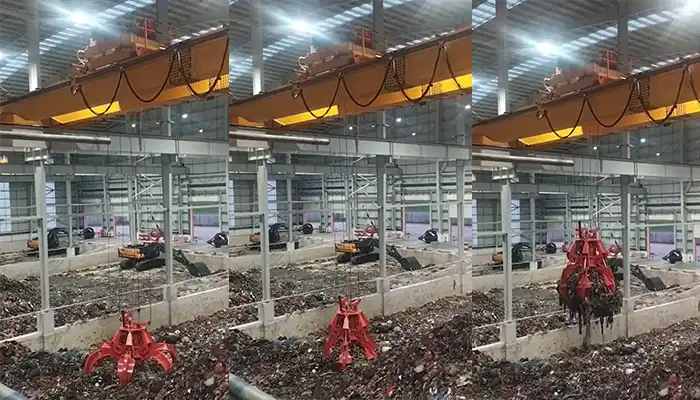
Supplied three grab bucket crane kits to Indonesia, enhancing garbage handling efficiency with high load capacity and reliable performance.
Free consultation to Confirm Parameters & Specifications and Get
Latest Crane Price & Crane Rate.
- Types of overhead cranes : _______?
- Optional: Overhead travelling crane, goliath gantry crane,Slewing jib crane, Single girder or double girder crane,small portable crane or kbk crane, etc.
- Capacity of overhead crane: _______?
- Optional: 0.25ton, 0.5 ton, 1 ton, 2 ton, 3ton, 5 ton, 10 ton,15ton, 20ton, 25 ton, 30ton,35ton, up to 550ton, etc.
- Crane span & lifting height : _______?
- Crane travelling length : _____?
- Control of overhead crane:_______?
- Optional: pendant/ remote/cabin control
- Voltage supply of overhead crane:_____?
- Eg,: 380V50/60HZ,3Phase or others,etc.
- Application/usage of crane:_______?
- Eg,: Steel mill, ,injection mold, cement,stone, concrete,granite, general manufacturing, etc.
Just leave a message via the contact form and our hoist and crane engineer will contact you with in 24working hours.
Get In Touch
